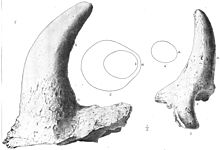Eoceratops
|
Eoceratops Temporal range: Late Cretaceous, 76.5–75 Ma |
|
|---|---|
 |
|
| The orbital horn core referred in 1902 to Monoclonius canadensis by Lambe, NMC 1254a, right, and nasal horn core of Monoclonius dawsoni NMC 190, left | |
| Scientific classification | |
| Kingdom: | Animalia |
| Phylum: | Chordata |
| Class: | Reptilia |
| Clade: | Dinosauria |
| Order: | †Ornithischia |
| Family: | †Ceratopsidae |
| Subfamily: | †Chasmosaurinae |
| Genus: |
†Eoceratops Lambe, 1915 |
| Type species | |
|
†Monoclonius canadensis Lambe, 1902 |
|
| Species | |
|
†Eoceratops canadensis (Lambe, 1902) Lambe, 1915 |
|
| Synonyms | |
|
Ceratops canadensis (Lambe, 1902) Hatcher vide Stanton & Hatcher, 1905 |
|
†Eoceratops canadensis (Lambe, 1902) Lambe, 1915
Ceratops canadensis (Lambe, 1902) Hatcher vide Stanton & Hatcher, 1905
Chasmosaurus canadensis (Lambe, 1902) Lehman, 1990
Mojoceratops perifania? Longrich, 2010
Eoceratops is a genus of ceratopsian dinosaurs containing the single species Eoceratops canadensis. It is a chasmosaurine ceratopsian which lived during the Late Cretaceous period, in what is now Western Canada.
In 1901, Lawrence Morris Lambe at the Berry Creek in Alberta discovered a dinosaur skull. In 1902, he named it as a new species of the genus Monoclonius: Monoclonius canadensis. The specific name referred to the provenance from Canada.
The holotype, NMC 1254, was found in an layer of the Belly River Group dating from the middle Campanian. It consists of a partial skull, lower jaw and front back vertebra, of a juvenile animal. The head elements include a right eye socket with brow horn, the right squamosal and parietal corner of the neck frill and the rear left lower jaw. Lambe thought he had also discovered a right jugal but this was later identified as the right nasal bone. In addition Lambe referred a right lower jaw, specimen NMC 284 found in 1897, and another brow horn, specimen NMC 190.
In 1905, in a publication by Timothy William Stanton and John Bell Hatcher, the species was assigned to the genus Ceratops, as a Ceratops canadensis. This was confirmed in Hatcher's posthumous publication of 1907. On this occasion, Hatcher additionally referred a maxilla and a tooth and suggested an identity with Monoclonius, later Chasmosaurus, belli.
...
Wikipedia
